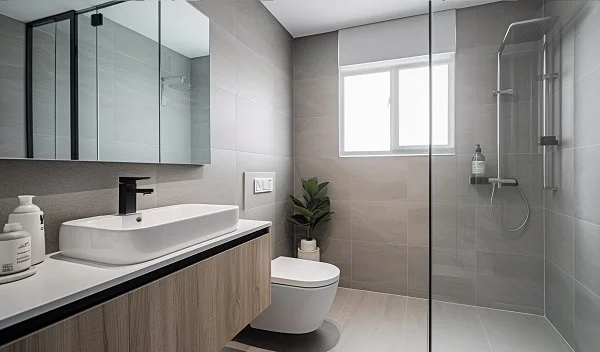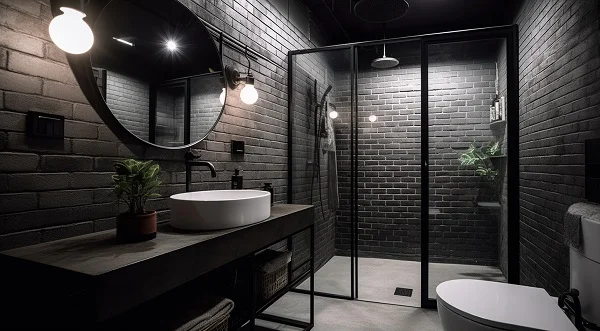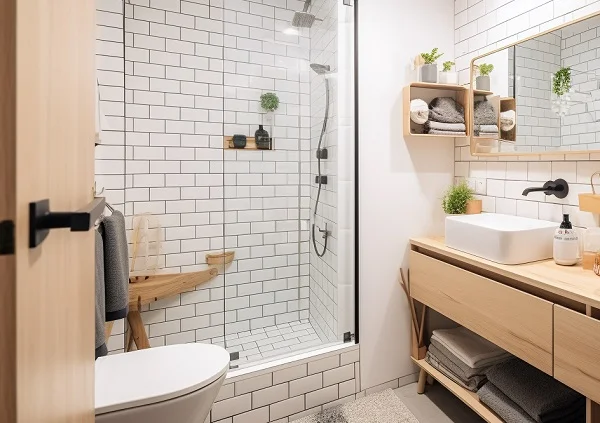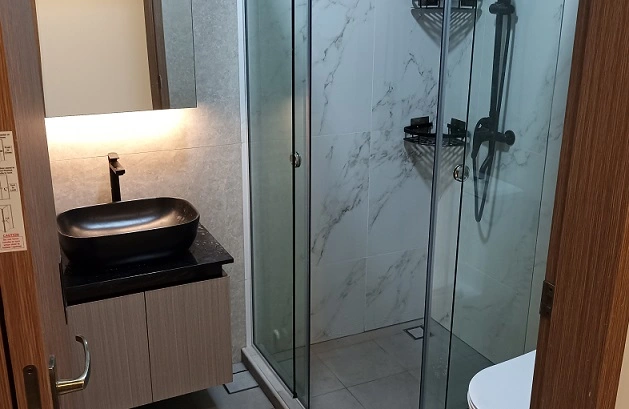HDB BTO toilet design is not merely about choosing fixtures and tiles. It’s about creating a space that reflects your style, anticipates your needs, and enhances your home’s overall aesthetic. It’s about making smart choices with materials, colours, and layouts. And, importantly, it’s about planning for the future, ensuring that your toilet design remains functional, safe, and appealing for years to come.
Over the next sections, we will navigate the broad spectrum of BTO toilet design, addressing every element, from the overall layout to the minute details. We will explore the current trends shaping BTO toilet design, discuss ways to optimise space and storage, delve into the importance of accessibility and safety, and consider sustainable design practices. Towards the end, we will share inspiring real-life transformations of BTO toilets, leaving you with a treasure trove of ideas and inspirations for your own home.
Whether you are planning to move into a BTO flat or considering a bathroom makeover, this comprehensive guide is your ally.
BTO Toilet Design Overview
BTO toilet design is not stagnant. Like any other aspect of interior design, it evolves with time, influenced by broader societal shifts, technological advancements, and changing tastes. In this section, we will explore the current trends shaping BTO toilet design.
One trend that has taken the world of BTO toilet design by storm is the minimalist style. As homeowners increasingly value simplicity, functionality, and tranquillity in their living spaces, minimalist design principles have found their way into the toilet. Clean lines, neutral colour palettes, uncluttered spaces, and a focus on essential items characterise this style. Minimalism doesn’t mean sacrificing style or comfort, but rather eliminating unnecessary elements and focusing on functionality and aesthetics in harmony.
The use of natural materials is another prominent trend. From stone and wood to bamboo and clay, nature-inspired materials bring a touch of the outdoors into your toilet, creating a serene, spa-like ambience. These materials are not only aesthetically pleasing but also durable and often more sustainable than synthetic counterparts.
Smart technology is revolutionizing BTO toilet design. Smart showers that save water, motion-sensor faucets, heated toilet seats, and even mirrors with inbuilt LED screens are not uncommon in modern BTO toilets. These innovations enhance comfort and convenience, making the toilet a space of luxury and relaxation.
Colour is making a comeback in BTO toilet design, challenging the dominance of the all-white bathroom. While neutrals remain popular, homeowners are increasingly experimenting with bold colours and patterns, often using them as accent elements. A statement wall in a vibrant hue or patterned tiles can instantly uplift the toilet’s look, adding personality and flair.
Sustainability is another significant trend influencing BTO toilet design. Eco-friendly fixtures, water-saving technologies, and energy-efficient lighting are some ways homeowners are reducing the environmental footprint of their toilets. Moreover, the use of locally sourced, recycled, and sustainable materials is gaining traction.
These trends reflect the dynamic nature of BTO toilet design, a space where style meets function, and innovation meets tradition. However, trends are merely inspirations. The key to a successful BTO toilet design lies in understanding your personal preferences and needs and translating them into a space that feels uniquely yours.
Exploring 5 Different Styles
When we talk about BTO toilet designs, the range of options is quite diverse. Here are the 5 popular styles:
- Modern minimalist

This design focuses on simplicity and functionality. Think clean lines, simple forms, and a monochrome color palette.
- Industrial style:

This style features exposed brick walls, rustic metals, and concrete, providing a raw and edgy look.
- Classic traditional:
With its timeless appeal, traditional design incorporates classic art, antiques, and pieces with history. The result is a warm, inviting space.
- Scandinavian:

Inspired by the simplicity of life in the Nordic countries, this design emphasizes functional, clean lines, and nature-inspired aesthetics.
- Eclectic:

For those who love to mix and match, the eclectic style offers a chance to blend different elements, textures, and colors.
Planning For A Toilet Renovation?
Key Elements
Space Utilization: The area of your BTO toilet plays a pivotal role in deciding its layout. However, size should not limit style or functionality. Smart design strategies can maximise small spaces, making them appear larger. For instance, a wall-mounted sink can free up floor space, making the toilet seem more spacious. On the contrary, a larger BTO toilet offers the freedom to incorporate a bathtub or a larger shower area.
Color Scheme: Colors profoundly impact the ambiance of a space. For BTO toilets, a light color palette can make the room appear larger and more spacious. However, don’t shy away from experimenting with bold colors. An accent wall or colorful fixtures can add a pop of vibrancy to your toilet. Remember, colors also need to match the lighting to create a soothing atmosphere.
Lighting: A well-lit toilet not only enhances functionality but also creates a warm and welcoming ambiance. Natural light is always a blessing, but if that’s not available, consider multiple light sources. Overhead lighting paired with task lighting around the mirror can eliminate shadows and create a balanced lighting scheme.
Fixtures: The choice of fixtures – toilets, sinks, faucets, showers, tubs – defines the style and functionality of your BTO toilet. While choosing fixtures, consider their design, ease of use, durability, and compatibility with the overall aesthetic of your toilet. For instance, a freestanding bathtub might enhance a vintage-style toilet, while a sleek, wall-mounted toilet fits perfectly in a minimalist design.
Storage: Efficient storage solutions are essential to maintain a clutter-free, organised BTO toilet. Cabinets, shelves, hooks, and baskets can serve as storage solutions. The key is to consider your storage needs and incorporate solutions that meet these without compromising on style.
Accessibility and Safety
When designing your BTO toilet, it’s essential to look beyond aesthetics and functionality to consider accessibility and safety. This aspect becomes particularly crucial if the house has elderly inhabitants or children. However, even for others, a safe and accessible toilet can significantly enhance comfort and convenience.
Accessibility involves designing the space so that all elements are easily reachable and usable by people with varied abilities. A height-adjustable sink, for example, can cater to both adults and children, while a walk-in shower eliminates the need to step over a high tub edge. Non-slip flooring can prevent accidents, while grab bars near the toilet and in the shower area can provide additional support.
Safety is closely linked to accessibility. Non-slip mats, adequately secured fixtures, and safe storage of potentially harmful items like cleaning agents are basic safety considerations. Additionally, ensure that your bathroom has proper ventilation to prevent the buildup of moisture and mould, which can create unhealthy living conditions.
Another safety aspect relates to electrical installations. All electrical fixtures should be safely distanced from water sources, and where necessary, ground fault circuit interrupters (GFCIs) should be installed to prevent electrical shocks.
When accessibility and safety are incorporated in the BTO toilet design from the beginning, they blend seamlessly with the overall aesthetics, creating a space that’s not just beautiful and functional but also secure and comfortable for all.
Sustainable and Eco-friendly
As awareness about our environment’s fragility grows, sustainable and eco-friendly design has made its way into our living spaces, including BTO toilets. More homeowners are seeking ways to reduce their environmental footprint, and rightfully so, given the bathroom’s significant water and energy consumption.
At the heart of a sustainable BTO toilet design is water efficiency. Water-saving fixtures like low-flow faucets, showerheads, and dual-flush toilets can significantly reduce water consumption without compromising performance. Another effective strategy is rainwater harvesting, where rainwater is collected, treated, and used for flushing toilets.
Energy efficiency is another crucial aspect of a sustainable BTO toilet. Energy-efficient lighting options like LEDs consume less electricity and last longer than traditional incandescent bulbs. Additionally, if you’re using electric heaters for your shower, consider solar water heaters or heat pump systems that are more energy-efficient.
Sustainability also extends to the choice of materials. Natural, locally-sourced, and recycled materials have lower environmental footprints compared to their synthetic counterparts. Bamboo, for example, is a fast-growing plant that can be used for flooring, cabinets, and even towels, while recycled glass can be used for countertops and tiles.
Moreover, a good ventilation system can prevent mold and mildew, improving indoor air quality. Plants can also be used to enhance air quality, and they add a refreshing touch of nature to your BTO toilet.
While incorporating these eco-friendly features may require a slightly higher initial investment, the long-term savings on water and electricity bills and the satisfaction of contributing to a healthier environment make it a worthwhile investment.
BTO Toilet Renovation Cost
Creating your dream BTO toilet need not burn a hole in your pocket. With careful planning and smart decisions, you can design a stylish and functional bathroom within your budget.
The first step is to establish a realistic budget, considering all elements from fixtures and fittings to labor costs. It’s also wise to set aside a contingency fund for any unexpected expenses.
To control costs, prioritize your needs. Investing in high-quality essentials like the toilet and shower is more important than splurging on luxury items. For instance, a good-quality, water-efficient toilet will serve you better in the long run than an expensive, high-tech mirror.
When choosing materials, look for durable and affordable options. Ceramic tiles, for instance, are cheaper than stone or glass and come in a wide variety of styles and colors. Similarly, laminate countertops are more affordable than granite or marble but can mimic their luxurious look.
If you’re working with a professional designer, discuss your budget upfront. A good designer will help you get the best value for your money, offering creative solutions to achieve your desired look within your budget.
Lastly, remember that the cheapest option is not always the most cost-effective. A slightly expensive, water-efficient faucet, for instance, might save you more money in the long run by reducing water bills than a cheap, wasteful one.
Planning For A Toilet Renovation?
Conclusion: The Journey to Your Dream BTO Toilet
Designing your BTO toilet is a journey – an opportunity to create a space that’s uniquely yours. Throughout this blog post, we’ve explored the numerous facets of this journey, from the key elements to consider and the trends shaping BTO toilet design, to the importance of accessibility, safety, sustainability, and cost considerations. We’ve also delved into real-world transformations, providing tangible examples of these principles in action.
To embark on this journey, start by understanding your needs and preferences. Think about the size of your toilet, the number of users, their ages and abilities, your environmental consciousness, and, importantly, your budget. Draw inspiration from current trends, but remember, these are just guides. Don’t shy away from breaking the mold and creating something that truly reflects your personality.
Next, consider the key elements – space utilization, color scheme, lighting, fixtures, and storage. Each of these elements contributes to the overall ambiance and functionality of your toilet. Choose materials and fixtures that are not just aesthetically pleasing but also durable, easy to maintain, and in line with your sustainability values.
Finally, don’t underestimate the importance of accessibility and safety. A well-designed toilet is not just beautiful and functional but also safe and comfortable for all users. From non-slip floors and grab bars to safely installed electrical fixtures, every detail matters.
In this journey, don’t hesitate to seek professional help if needed. A good designer can offer invaluable advice, helping you navigate the myriad decisions and ensure that the end result is a bathroom you love.
Remember, your BTO toilet is more than just a room. It’s a personal sanctuary, a space where you start and end your day. With careful planning, a touch of creativity, and a dose of patience, you can transform it into a haven that combines style, function, comfort, and sustainability. Here’s to the journey of creating your dream BTO toilet!
Why is BTO toilet design important?
BTO toilet design is essential for both functional and aesthetic reasons. It impacts the daily usability of the space and can contribute significantly to the overall value of your BTO flat. With thoughtful design, even small bathrooms can be transformed into beautiful, efficient spaces.
How can I maximize space in my BTO toilet design?
There are several strategies to maximize space in a BTO toilet. These include choosing wall-mounted fixtures, using mirrored surfaces to visually expand the space, implementing smart storage solutions, and selecting a light color scheme to make the room appear larger.
What are some popular BTO toilet design styles?
There are numerous styles you can choose from when designing your BTO toilet. Some popular ones include the modern minimalist style, industrial style, traditional style, Scandinavian style, and eclectic style. The best style for your BTO toilet will depend on your personal preferences and the overall aesthetic of your home.
How should I plan my BTO toilet design?
When planning your BTO toilet design, start by assessing the available space and considering the functionality you need. Choose a design style, decide on the layout, and select fixtures and accessories that align with your chosen style. Consider your storage needs, and don’t forget about lighting, ventilation, and sustainability.
Where to choose tiles?
We recommend Hafary or Soon Bee Huat for your bathroom tiles.
